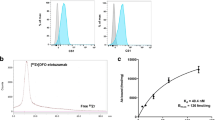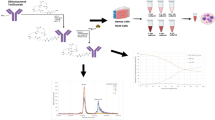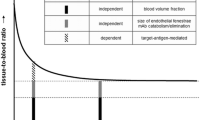Abstract
The biodistribution of indium-111/yttrium-88-labeled B3 monoclonal antibody, a murine IgG1k, was evaluated in non-tumor-bearing mice. B3 was conjugated to either 2-(p-SCN-Bz)-6-methyl-DTPA (1B4M) or 2-(p-SCN-Bz)-1,4,7,10 tetraazacyclododecane tetra-acetic acid (2B-DOTA) and labeled with 111In at 1.4–2.4 mCi/mg and 88Y at 0.1–0.3 mCi/mg. Non-tumor-bearing nude mice were co-injected i.v. with 5–10 μCi/4–10 μg of 111In/88Y-labeled B3 conjugates and sacrificed at 6 h and daily up to 168 h post-injection. Mice injected with 111In/88Y (IB4M)-B3 showed a similar biodistribution of the two radiolabels in all tissues except the bones, where significantly higher accretion of 88Y than 111In was observed, with 2.8% ± 0.2% vs 1.3% ± 0.16% ID/g in the femur at 168 h, respectively (P<0.0001). In contrast, mice receiving the 111In/88Y-(DOTA)-B3 conjugate showed significantly higher accumulation of 111In than 88Y in most tissues, including the bones, with 2.0% ± 0.1% vs 1.2% ± 0.09% ID/g in the femur at 168 h, respectively (P<0.0001). Whereas the ratios of the areas underneath the curve (%ID × h/g) in the blood, liver, kidney and bone were 0.96, 1.12, 1.13, and 0.74 for 111In/88Y-(IB4M)-B3 and 0.84, 1.23, 1.56, and 1.31 for 111In/88Y (DOTA)-B3, respectively, ratios ≈ 1 were observed between 111In-(IB4M)-B3 and 88Y-(DOTA)-B3. In summary, while neither IB4M nor DOTA was equally stable for 111In and 88Y, the fate of 88Y- (DOTA)-B3 could be closely traced by that of 111 In-(IB4M)-B3.
Similar content being viewed by others
References
Buchsbaum DJ, Langmuir VK, Wessels BW. Experimental radioimmunotherapy. Med Phys 1993; 20: 551–567.
Order SE, Sleeper AM, Stillwagon GB, Klein JL, Leichner PK. Radiolabeled antibodies: results and potential in cancer therapy. Cancer Res 1990; 50(Suppl):1011s–1013s.
Kozak RW, Atcher RW, Gansow OA, Friedman AM, Hines JJ, Waldmann TA. Bismuth-212-labeled anti-Tac monoclonal antibody: α-particle emitting radionuclides as modalities for radioimmunotherapy. Proc Natl Acad Sci USA 1986; 83: 474–478.
Deshpande SV, DeNardo SJ, Meares CF, et al. Copper-67-labeled monoclonal antibody Lym-1, a potential radiopharmaceutical for cancer therapy: labeling and biodistribution in RAJI tumored mice. J Nucl Med 1988; 29: 217–225.
Zalutsky MR, Garg PK, Friedman HS, Bigner DD. Labeling monoclonal antibodies and F(ab')2 fragments with the α-particle-emitting nuclide astatine-211: preservation of immunoreactivity and in vivo localization capacity. Proc Natl Acad Sci USA 1989; 86: 7149–7153.
Beaumier PL, Venkasten P, Vanderheyden J-L, et al. 186Re radioimmunotherapy of small cell lung carcinoma xenografts in nude mice. Cancer Res 1991; 51: 676–681.
Schlom J, Siler K, Milenic DE, et al. Monoclonal anti-bodybased therapy of a human tumor xenograft with a 177Iutetium-labeled immunoconjugate. Cancer Res 1991; 51: 2889–2896.
Anderson-Berg WT, Squire RA, Strand M. Specific radioimmunotherapy using 90Y labeled monoclonal antibody in erythroleukemic mice. Cancer Res 1987; 47: 1905–1912.
Sharkey RM, Kaltovich FA, Shih LB, Fand I, Govelitz G, Goldenberg DM. Radioimmunotherapy of human colonic cancer xenografts with 90Y labeled monoclonal antibodies to carcinoembryonic antigen. Cancer Res 1988; 48: 3270–3275.
Lee YC, Washburn LC, Sun TTH, et al. Radioimmunotherapy of human colorectal carcinoma xenografts using 90Y labeled monoclonal antibody C017-A prepared by two bifunctional chelate techniques. Cancer Res 1990; 50: 4546–4551.
Stewart JSW, Hird V, Snook D, et al. Intraperitoneal yttrium-90-labeled monoclonal antibody in ovarian cancer. J Clin Oncol 1990; 8: 1941–1950.
Chinol M, Hnatowich DJ. Generator-produced yttrium-90 for radioimmunotherapy. J Nucl Med 1987; 28: 1465–1470.
Wessels BW, Rogus RD. Radionuclide selection and model absorbed dose calculations for radiolabeled tumor associated antibodies. Med Phys 1984; 11: 638–645.
Naruki Y, Carrasquillo JA, Reynolds JC, et al. Differential cellular catabolism of 111In, 90Y and 125I radiolabeled T101 anti-CD5 monoclonal antibody. Nucl Med Biol 1990; 17: 201–207.
Maecke HR, Riesen A, Ritter W. The molecular structure of indium-DTPA. J Nucl Med 1989; 30: 1235–1239.
Cotton FA, Wilkinson G. Advanced inorganic chemistry, 5th edn. New York: John Wiley, 1988.
Roselli M, Schlom J, Gansow OA, et al. Comparative biodistribution of yttrium- and indium-labeled monoclonal antibody B72.3 in athymic mice bearing human colon carcinoma xenografts. J Nucl Med 1989; 30: 672–682.
Quadri SM, Vriesendorp HM, Leichner PK, Williams JR. Evaluation of indium-111- and yttrium-90-labeled linker-immunoconjugates in nude mice and dogs. J Nucl Med 1993; 34: 938–945.
Jowsey J, Rowland RE, Marshall JH. The deposition of rare earths in bone. Radiat Res 1958; 8: 490–501.
Brechbiel MW, Gansow OA, Atcher RW, et al. Synthesis of 1-(p-isothiocyanatobenzyl) derivatives of DTPA and EDTA. Antibody labeling and tumor-imaging studies. Inorg Chem 1986; 25: 2772–2781.
Hnatowich DJ, Virzi F, Doherty PW. DTPA-coupled antibodies labeled with yttrium-90. J Nucl Med 1985; 26: 503–509.
Kozak RW, Raubitschek A, Mirzadeh S, et al. Nature of the bifunctional chelating agent used for radioimmunotherapy with yttrium-90 monoclonal antibodies: critical factors in determining in vivo survival and toxicity. Cancer Res 1989; 49: 2639–2644.
Sharkey RM, Motta-Hennessy C, Gansow OA, et al. Selection of a DTPA chelate conjugate for monoclonal antibody targeting to a human colonic tumor in nude mice. Int J Cancer 1990;46: 79–85.
Washburn LC, Sun TTH, Lee YCC, et al. Comparison of five bifunctional chelate techniques for 90Y labeled monoclonal antibody C017-1A. Nucl Med Biol 1991; 18: 313–321.
Cox JPL, Jankowski KJ, Kataky R, Parker D, Beeley NRA, Boyce BA, Eaton MAW, Millar K, Millican AT, Harrison A, Walker C. Synthesis of a kinetically stable yttrium-90 labeled macrocycle-antibody conjugate. J Chem Soc Chem Commun 1989;797–798.
Moi MK, DeNardo SJ, Meares CF. Stable bifunctional chelates of metals used in radiotherapy. Cancer Res 1990; 50 (Suppl):789s–793s.
Deshpande SV, DeNardo SJ, Kukis DL, et al. Yttrium-90-labeled monoclonal antibody for therapy: labeling by a new macrocyclic bifunctional chelating agent. J Nucl Med 1990; 31: 473–479.
Harrison A, Walker CA, Parker D, et al. The in vivo release of 90Y from cyclic and acyclic ligand-antibody conjugates. Nucl Med Biol 1991; 18: 469–476.
Meares CF, Moi MK, Diril H, et al. Macrocyclic chelates of radiometals for diagnosis and therapy. Br J Cancer 1990; 62(Suppl X): 21–26.
Snook DE, Rowlinson-Busza G, Meares CF, Epenetos AA. Indium-111-and yttrium-90-labelled macrocyclic chelating agents. In: Expenetos A (ed) Monoclonal antibodies: applications in clinical oncology, 1st edn. London: Chapman & Hall; 1991: 157–166.
Wu C, Virzi F, Hnatowich DJ. Investigation of N-linked macrocycles for 111In and 90Y labeling of proteins. Nucl Med Biol 1992; 19: 239–244.
Kosmas C, Snook D, Gooden CS, et al. Development of humoral immune responses against a macrocyclic chelating agent (DOTA) in cancer patients receiving radioimmunoconjugates for imaging and therapy. Cancer Res 1992; 52: 904–911.
Camera L, Kinuya S, Garmestani K, Wu C, Brechbiel MW, Pai LH, McMurry TJ, Gansow OA, Pastan I, Paik CH, Carrasquillo JA. Evaluation of the serum stability and in vivo biodistribution of the 2-(p-isothiocyanatobenzyl)-cyclohexyl-DTPA (CHX-DTPA) and other ligands for yttrium-labeling of monoclonal antibodies. J Nucl Med 1994; 35: 882–889.
McMurry TJ, Brechbiel MW, Kumar K, Gansow OA. Convenient synthesis of bifunctional tetraaza macrocycles. Bioconjugate Chem 1992; 3: 108–117.
Brechbiel MW, Gansow OA. Backbone-substituted DTPA ligands for 90Y radioimmunotherapy. Bioconjugate Chem 1991; 2: 187–194.
Pastan I, Lovelace ET, Gallo MG, Rutherford AV, Magnani JL, Willingham MC. Characterization of monoclonal antibodies B1 and B3 that react with mucinous adenocarcinomas. Cancer Res 1991; 51: 3781–3787.
Mirzadeh S, Brechbiel MW, Atcher R, Gansow OA. Radiometal labeling of immunoproteins: covalent linkage of 2-(4-isothiocyanatobenzyl)diethylenetriaminepentaacetic acid ligands to immunoglobulin. Bioconjugate Chem 1990; 1: 59–65.
Martell AE, Smith RM. Critical stability constants. New York: Plenum Press, 1974.
Kodama M, Koike T, Mahatma AB, Kimura E. Thermodynamic and kinetic studies of lanthanide complexes of 1,4,7,10,13-pentaazacyclopentadecane-N,N′,N″,N″′,N″″-pentaac etic acid and 1,4,7,10,13,16-hexaazacyclooctadecane-N,N′,N″,N″′, N″″,N″″′-hexaacetic acid. Inorg Chem 1991; 30: 1270–1273.
Mardirossian G, Wu C, Hnatowich DJ. The stability in liver homogenates of indium-111 and yttrium-90 attached to antibody via two popular chelators. Nucl Med Biol 1993; 20: 65–74.
Shannon RD. Revised effective ionic radii and systematic studies of interatomic distances in halides and chalcogenides. Acta Crystlogr A 1976; 32: 751–767.
Basolo F, Pearson RG. Mechanism of inorganic reactions. 2nd edn. New York: John Wiley, 1967.
Author information
Authors and Affiliations
Rights and permissions
About this article
Cite this article
Camera, L., Kinuya, S., Garmestani, K. et al. Comparative biodistribution of indium- and yttrium-labeled B3 monoclonal antibody conjugated to either 2-(p-SCN-Bz)-6-methyl-DTPA (1 B4M-DTPA) or 2-(p-SCN-Bz)-1,4,7,10-tetraazacyclododecane tetraacetic acid (2B-DOTA). Eur J Nucl Med 21, 640–646 (1994). https://doi.org/10.1007/BF00285586
Received:
Revised:
Issue Date:
DOI: https://doi.org/10.1007/BF00285586




